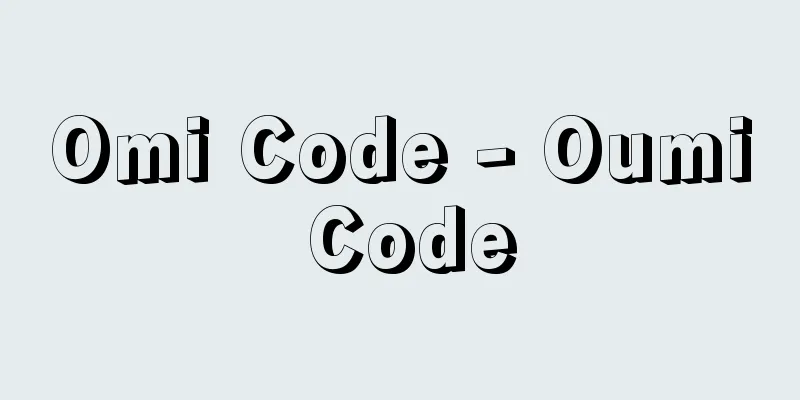Sugar - Sugar (English spelling)

|
A sweetener whose main component is sucrose (sugar) made from sugar cane or sugar beet. It may also contain other sugars with a sweet taste, such as glucose or maltose. [Tomomi Kono and Midori Otaki] historyThe history of sugar is very old, and it is said that in 327 BC, when Alexander the Great sent an expeditionary force to India, his commander, General Nearches, discovered it there. He reported that "honey was made from the stalks of reeds without the help of bees." Also, in 320 BC, Megasthenes, a Greek who had been stationed in India, introduced sugar as "sekimitsu (stone syrup)." As the character for "stone" is used, it is safe to assume that solid sugar was already in use at that time. The first mention of it in a Chinese document was in the "Yiwu Zhi," which states that cane sugar existed in Jiaozi (Vietnam). The "Book of the Later Han" (a Chinese historical book from the 1st to 3rd centuries) also records the existence of syrup in India. For these reasons, it is believed that sugar was first produced in India, and its raw material, sugarcane, was probably already being cultivated in India around 2000 BC. Sugar spread from India to China, Thailand, and Java in the 5th and 6th centuries. It also spread to Europe via Central Asia. In the 8th century, it spread to the Mediterranean coast via Cyprus, and was then transplanted to southern Africa. After Columbus discovered the Americas in 1492, the Spanish and Portuguese advanced into the New World, and introduced sugarcane cultivation to Latin American countries such as Cuba, Puerto Rico, Mexico, and Brazil. By the 16th century, these regions had developed into some of the world's leading sugar-producing countries. Sugar is said to have first been introduced to Japan in the Nara period, when the Chinese monk Ganjin brought brown sugar with him when he visited Japan in 754 (Tenpyo Shoho 6). There is an entry for "sucrose" in the "Tōdai-ji Temple Offerings Book" (756), which was used for medicinal purposes. In the Muromachi period, trade with China flourished, and sugar imports also increased. However, the amount was tiny, and the situation remained the same until the Edo period. The method of sugar production was introduced to Japan during the Keicho era (1596-1615), when Sunakawa Satoshi from Amami Oshima was washed ashore in Fujian, China, due to a typhoon, where he learned the techniques of sugarcane cultivation and sugar production, and secretly brought back sugarcane seedlings and planted them. The Nanto Zatsuwa also states that it began during the Genroku era (1688-1704). Records show that sugarcane was cultivated in the Ryukyus as early as 1534 (Tenbun 3), but sugar production came later than in Amami, when Gima Shinjo sent villagers to Fujian on a tribute ship in 1623 (Genwa 9) to learn sugar production techniques. The Satsuma Domain began purchasing all sugar from the three islands (Oshima, Kikaijima, and Tokunoshima) and instituted a tribute system for sugar produced in the Ryukyus, aiming to monopolize it. In addition to brown sugar, white sugar was also produced, but while 5 to 6 jin of brown sugar could be obtained from 1 to of millet juice, only a little less than 1 jin of white sugar was produced. The eighth shogun, Yoshimune, restricted sugar imports and encouraged domestic production. Japanese sugar was initially a product monopoly of the Satsuma Domain, but by the end of the Edo period, sugar was being produced in Sanuki, Awa, Tosa, Izumi, Kawachi, and other places, and white sugar was also being produced. White sugar was further refined into pure white crystals, a high-quality product called Sanbon or Sanbonjiro, and was highly valued. The name Sanbon is said to come from the fact that it is kneaded three times on a tray (earthenware bowl) to refine it, or from the fact that the Chinese who imported it had the rank of Sanbon (third rank). At first, Japan relied on imports, but gradually domestically produced Sanbon (also called Wasanbon) began to appear, and Sanuki Sanbon Shiro in particular was known for its high quality (note that white sugar made using modern methods is sometimes called "Sanbon Shiro"). However, sugar was still a valuable commodity for the common people in the Edo period, and it was not until the Meiji period that sugar became widely used in Japan. Meanwhile, beet sugar, made from sugar beets, only became popular in Europe after Napoleon blockaded the European continent in 1806, and was introduced to Japan in 1876 (Meiji 9) when Kuroda Kiyotaka was the governor of the Hokkaido Colonization Agency. With the occupation of Taiwan after the First Sino-Japanese War (1894-1895), a full-scale sugar manufacturing industry was established and sugar production increased dramatically, but today most raw sugar is imported and refined domestically. [Tomomi Kono and Midori Otaki] kindsTypes of sugar can be divided into those based on their raw materials: cane sugar made from sugar cane, beet sugar made from sugar beets, maple sugar made from the sap of sugar maples, palm sugar made from the sap of sugar palms and coconut palms, and sorghum sugar made by squeezing the juice from the stalks of sorghum, which is similar to sugarcane. The most common types are cane sugar and beet sugar. In terms of manufacturing method, there are two types: "molasses-containing sugar," which contains molasses, and "fractional sugar," from which the molasses has been separated. Fractional sugar is the type used in daily life. Molasses sugar is black in color because it contains molasses, and has a strong sweetness and a distinctive molasses smell. It is made up of sucrose, but also contains small amounts of minerals and vitamins. Brown sugar, commonly called black sugar, is made by adding lime to the juice squeezed from sugarcane to neutralize the liquid, filtering out impurities, concentrating the liquid as is, and solidifying it. In Japan, it is produced in Okinawa and Amami Oshima. Other types include coarse powdered brown sugar mixed with small reddish brown lumps, semi-solid shiroshita sugar mixed with small crystal particles, and re-refined sugar made by mixing various types of molasses sugar, refined sugar, molasses, etc. and heating it again. In Shikoku, wasanbon (sanbon white) is made for high-quality Japanese sweets by repeatedly adding water to shiroshita sugar and squeezing it. Most refined sugar is white in color because the molasses is separated and refined. Raw sugar is made by removing impurities from the squeezed juice of sugarcane at the production site, crystallizing it, and then removing the molasses using a centrifuge to make raw sugar, which is then refined at a refinery. White sugar can also be made directly from sugarcane, in which case the white sugar is called cultivated white sugar. Refined sugar is broadly divided into granulated sugar and brown sugar. Granulated sugar has fine crystals and a moist feel, and is also called soft sugar. Note that granulated sugar is sprinkled with bisco (sugar broken down into glucose and fructose with hydrochloric acid) to maintain its moistness and prevent it from solidifying. It has a strong sweetness because it contains fructose, and for this reason granulated sugar is sweeter than brown sugar without the addition of bisco. The type of sugar that is commonly used in Japan is white sugar, which belongs to granulated sugar and is called white sugar. Other types include medium white sugar, which is slightly less pure than white sugar and has a light brown color, and brown sugar, which is even less pure than medium white sugar and has an even yellowish brown color, but medium white sugar is rarely seen these days. Zaratou is a refined sugar with larger crystals than granulated sugar and a higher sucrose purity. Zaratou has a hard crystal feel, so it is also called hard sugar. Granulated sugar has the smallest crystals of all types of brown sugar, and is used at home in tea and coffee. Other types include white rough sugar and medium rough sugar (yellow rough sugar), which is slightly less pure than white rough sugar and has a light yellowish brown color. White rough sugar also comes in different sizes of crystals, and generally the larger the crystals, the higher the purity and the higher the quality. Some medium rough sugar is colored with caramel. Processed sugar includes powdered sugar, sugar cubes, and rock sugar. All of these are made from granulated sugar or white coarse sugar. Powdered sugar is made by grinding white coarse sugar or granulated sugar, and often contains added soluble starch to prevent caking. It is used to decorate fruits and cakes. Sugar cubes are made by mixing granulated sugar with granulated sugar dissolved in a small amount of water and pressing it into cubes or various shapes. Rock sugar, also called crystal sugar, is made by dissolving granulated sugar in water and creating large crystals from the thick sugar solution. Depending on the manufacturing method, the crystals can be either irregular or uniform in size. Other types include granulated sugar and liquid sugar. Granulated sugar is made by solidifying fine powdered sugar to make it porous, and is easily soluble in cold water, making it suitable for cold drinks such as iced coffee and yogurt. Liquid sugar can be made by dissolving granulated sugar, sugar before it is crystallized, or sugar made by replacing some or all of the sucrose with invert sugar. It is used in confectionery, soft drinks, etc. [Tomomi Kono and Midori Otaki] Manufacturing methodSugar manufacturing and refined sugar are made through the processes of refining, crystallization, and molasses separation. For example, with sugarcane, sugarcane is harvested and the juice is squeezed out of the stalks. Lime is added to this sugar juice, which is filtered to remove impurities, and then concentrated in an evaporator. This is further concentrated in a vacuum crystallizer, and small sugar crystals are added as crystal seeds, which act as nuclei to crystallize supersaturated sucrose, which is then centrifuged to separate the molasses. This is the raw sugar. It is imported to Japan in this state from various countries. At sugar refineries, raw sugar is dissolved in hot water, refined with activated carbon and ion exchange resin, and then placed in a condenser and concentrated under reduced pressure. When it becomes supersaturated, crystal seeds are added to create crystals. If a large number of seeds are added and cooled quickly, fine crystals like granulated sugar are produced, and if fewer seeds are used and cooled slowly, large crystals like brown sugar are obtained. Once the crystals are formed, they are separated from the mother liquor in a centrifuge, and then dried and cooled to become the product. The products are packaged according to their intended use, from home use to commercial use. To make beet sugar, sugar beets are washed, cut into thin slices, and then introduced into a leaching device where the sugar is extracted using warm water. The sugar liquid is refined and concentrated, and then crystallized, separated, dried, and cooled in the same way as cane sugar refining. [Tomomi Kono and Midori Otaki] consumptionSugar consumption is said to be a barometer of civilization, and generally speaking, the more civilized a country is, the more sugar it tends to consume. In Japan, consumption is increasing year by year, reaching nearly 30 kilograms per person per year in 1972 (Showa 47). However, with the rapid increase in isomerized sugar, which is made from starch, since the mid-1970s, sugar consumption has been declining. Most of the sugar consumed in Japan is imported from abroad, with domestic production accounting for about 30% of Japan's total consumption. Hokkaido, Okinawa, and Kagoshima are the main sugar-producing areas. [Tomomi Kono and Midori Otaki] PhysiologyMost sugar is sucrose, which is easily absorbed by the body. The absorbed sugar is mainly used as an energy source. A sucrose molecule is a combination of one glucose molecule and one fructose molecule, and is broken down into fructose and glucose in the body, and fructose eventually becomes glucose and is used as an energy source. However, if consumed in excess, some of it is stored in the liver and muscle cells as glycogen, and the excess glucose is converted into neutral fats. Also, be careful not to consume foods that contain a lot of sugar before a meal, as this can increase the sugar level in the blood, which can make you feel full and make it difficult to eat. When you are very tired, consuming sugar quickly replenishes the sugar in your blood and serves as an energy source, so you can recover your energy. One gram of sugar contains approximately 4 kilocalories of energy, so a cup of coffee containing about 8 grams of sugar (about 2 teaspoons) contains about 30 kilocalories. [Tomomi Kono and Midori Otaki] cookingSugar has strong dehydrating and water-retaining properties, and these physical properties are widely used in addition to adding sweetness to dishes. Candied foods, candied preserves, jams, and yokan are some of the products that use its dehydrating properties to improve shelf life. In meringues, dehydration with sugar prevents the air bubbles from collapsing after whipping egg whites. In jellies, dehydration from the colloidal liquid helps separate the gelling agents gelatin and pectin and form a network structure, accelerating gelation and maintaining the jelly-like texture. In mochi (rice cake) confections, sweet breads, cakes, and other products, the dehydrating and water-retaining properties of sugar prevent aging and keep them moist. When sugar is boiled, it changes into a different form from the original sugar depending on the boiling temperature. A thick syrup is made at 102-105°C, and fondant (also called syrup) is made by boiling it to 110-115°C and stirring vigorously to create fine crystals, while caramel is made by heating it to 160-180°C. Fondant is used in sweets, while caramel has a unique aroma and bitter taste and is used to flavor puddings. [Tomomi Kono and Midori Otaki] "Artisans of Natural Flavors -- Sugar, Salt, and Soy Sauce" by Yoshiba Kazuo (1993, Shin Nihon Shuppansha)" ▽ "Modern Japanese Sugar Industry History, Volume 2, edited by the Sugar Industry Association (1997, Keiso Shobo)" ▽ "Sugar (a precious seasoning)" edited by Aspect (2000, Aspect)" ▽ "Modern Japanese Sugar Industry History, edited by the Sugar Industry Association (2002, Maruzen Planet, Maruzen Publishing)" ▽ "The History of Brown Sugar -- A Look at Documents from Okinawa and Amami" by Naka Masahachiro (2003, Border Ink)" ▽ "The World History of Sugar" by Kawakita Minoru (Iwanami Junior New Books)" ▽ "The Misconception that 'Sugar Makes You Fat'" by Takada Akikazu (Kodansha, Bluebacks) [References] | | | | | | | | | |©Shogakukan "> Sugar manufacturing process Source: Shogakukan Encyclopedia Nipponica About Encyclopedia Nipponica Information | Legend |
|
サトウキビ(甘蔗(かんしょ))またはサトウダイコン(甜菜(てんさい))を材料としてつくったショ糖(サッカロース)を主成分とする甘味料。ブドウ糖、麦芽糖など、他の甘味をもつ糖類を含めることもある。 [河野友美・大滝 緑] 歴史砂糖の歴史は非常に古く、紀元前327年、アレクサンドロス大王がインドに遠征軍を送った際、その司令官ネアチェス将軍がインドで発見したという。彼は「ハチの助けを借りずに、葦(あし)の茎から蜜(みつ)をつくっている」と報告している。また、前320年には、インドに駐在したことのあるギリシア人メガステネスが、砂糖のことを「石蜜(せきみつ)」と紹介した。石の字が使われているところから、当時すでに固形の砂糖が用いられていたと考えてよい。中国の文書では『異物志』の記載が最初で、それには交趾(こうち)(ベトナム)に甘蔗糖のあったことが紹介されている。また『後漢書(ごかんじょ)』(1~3世紀の中国の史書)でもインドに石蜜のあることが記されている。これらのことから、砂糖はインドで初めてつくられたと考えられ、その原料となったサトウキビは、前2000年ごろインドですでに栽培されていたようである。 砂糖は5~6世紀ごろには、インドから中国、タイ、ジャワに普及した。一方、中央アジアを経てヨーロッパにも伝わった。8世紀になると、キプロス島を経て地中海沿岸にも普及し、その後アフリカ南部にまで移植された。1492年コロンブスのアメリカ大陸発見後、スペイン人、ポルトガル人が新大陸に進出するとともに、キューバ、プエルト・リコ、メキシコ、ブラジルなどの中南米諸国にもサトウキビの栽培を伝えた。これらの地方は、16世紀ごろには世界屈指の砂糖産出国にまで発展した。 日本への砂糖の渡来は奈良時代、754年(天平勝宝6)に唐僧鑑真(がんじん)が来日の際、黒糖を持ってきたのが最初といわれている。「東大寺献物帳」(756)にも「蔗糖」の記事がみえるが、これは薬用に用いられていた。室町時代に入って、中国との貿易が盛んとなり、砂糖の輸入も多くなった。しかしその量は微々たるもので、同じような状態が江戸時代まで続いた。 日本に製糖法が伝わったのは、慶長(けいちょう)年間(1596~1615)奄美(あまみ)大島の直川智(すなおかわち)が台風のため中国福建に漂着し、そこでサトウキビ栽培と製糖の技術を習得、ひそかにサトウキビの苗を持ち帰って植え付けたのに始まるという。『南島雑話』には元禄(げんろく)年間(1688~1704)創始説も記されている。琉球(りゅうきゅう)では、1534年(天文3)サトウキビの栽培が行われていたことが記録にみえるが、製糖は奄美より遅れ、1623年(元和9)儀間真常(ぎましんじょう)が村人を貢船に便乗させて福建に遣わし製糖技術を習わせたことによる。 薩摩(さつま)藩は、三島(大島・喜界(きかい)島・徳之島)の砂糖総買入れを始め、琉球産にも貢糖制度を定めて独占を図った。黒糖のほか白糖もつくられたが、黍(きび)汁1斗から黒糖5~6斤が得られるのに対し、白糖はわずか1斤弱にすぎなかった。8代将軍吉宗(よしむね)は、砂糖の輸入を制限し、国産を奨励した。和製砂糖は初め薩摩藩の独占的産物であったが、江戸末期には、讃岐(さぬき)、阿波(あわ)、土佐、和泉(いずみ)、河内(かわち)などでも製糖が行われ、白砂糖もつくられるようになった。白砂糖をさらに精製して純白の結晶とした高級品は、三盆(さんぼん)・三盆白(さんぼんじろ)とよばれて珍重された。三盆の名は、精白のために3回、盆(土製の鉢)の上でもんだためとか、あるいはそれを舶載した中国人の官位が三品(さんぼん)であったことに由来するともいわれる。初め輸入に頼っていたが、しだいに国産(和三盆(わさんぼん)ともいう)も現れ、とくに讃岐の三盆白は上品として知られた(なお、近代製法による上白糖を「三盆白」とよんだこともある)。しかし、江戸時代の庶民にとって砂糖はまだまだ貴重品で、砂糖が本格的に日本に普及したのは明治以後のことである。 一方、サトウダイコンを材料としてつくる甜菜糖がヨーロッパに普及したのは、ナポレオンが1806年にヨーロッパ大陸を封鎖したとき以来のことで、日本へは1876年(明治9)に黒田清隆(きよたか)が北海道開拓使長官のとき移入された。日清(にっしん)戦争(1894~1895)後の台湾領有によって本格的な製糖業が行われ、砂糖生産額は飛躍的に伸びたが、現在では粗糖のほとんどを輸入に頼り、国内で精製する方式をとっている。 [河野友美・大滝 緑] 種類砂糖の種類としては、その原料面から分けると、サトウキビからつくる甘蔗糖、サトウダイコン(テンサイ、ビート)からつくる甜菜糖(ビート糖)、サトウカエデの樹液からつくるかえで糖(メープルシュガー)、サトウヤシやココヤシの樹液を集めてつくるやし糖、サトウキビに似たモロコシの茎から汁を絞ってつくるもろこし糖(ソルガムシュガー)などがある。主力は甘蔗糖と甜菜糖である。また製法から分けると、糖蜜分を含む「含蜜糖」と、糖蜜分を分離した「分蜜糖」の二つとなる。日常使用されているのは、ほとんどが分蜜糖である。 含蜜糖は糖蜜を含んでいるため色が黒く、また強い甘味とともに特有の糖蜜臭をもっている。成分はショ糖分であるが、無機質やビタミン類が少量含まれている。黒糖は普通、黒砂糖とよばれ、サトウキビを絞った汁に石灰を加えて液を中性にし、夾雑(きょうざつ)物を漉(こ)してそのまま濃縮し、固まらせた砂糖で、日本では沖縄、奄美大島で産する。このほか赤褐色の小さい塊の混ざった粗い粉状の赤糖、小さな結晶粒子の混ざった半固形の白下(しろした)糖、各種の含蜜糖や精製糖、糖蜜などを配合し、加熱し直してつくる再製糖などがある。四国では、白下糖に水を加えて絞ることを繰り返してつくる高級和菓子用の和三盆(三盆白)がつくられる。 分蜜糖は、糖蜜が分離され、精製されているので、色の白いものがほとんどである。生産地でサトウキビの絞り汁から不純物を取り除き結晶化させたのち糖蜜を遠心分離機で除いたものが原料糖で、これを精製工場で精製したものが精製糖である。サトウキビから直接白砂糖をつくることもあるが、この場合の白砂糖は耕地白糖とよばれる。精製糖は、車(くるま)糖とざらめ糖に大きく分けられる。車糖は結晶が細かくしっとりした感じがあり、ソフトシュガーともよばれる。なお、車糖には、湿潤性の保持と固結防止のため、ビスコ(砂糖を塩酸で分解してブドウ糖と果糖にしたもの)がふりかけられている。果糖を含むため甘味が強く、このために車糖はビスコを加えないざらめ糖より甘ったるい。日本で通常よく使用されるのは上白糖で、これは車糖に属し、白砂糖とよばれている。このほか上白糖よりやや純度が低く淡褐色の中白糖(ちゅうじろとう/ちゅうはくとう)や、中白糖よりさらに純度が低く黄褐色の三温糖(さんおんとう)があるが、中白糖は最近は一般にはほとんどみられない。ざらめ糖は、車糖に比べて結晶の大きい精製糖で、ショ糖分の純度が高い。ざらめ糖は結晶の感じが固いので、ハードシュガーともよばれている。ざらめ糖のなかでいちばん結晶の小さいのがグラニュー糖で、家庭で紅茶、コーヒーなどに用いられる。このほか白ざら糖、白ざら糖よりやや純度が低く、うすい黄褐色をした中ざら糖(黄ざら糖)などがある。また白ざら糖にも結晶の大小があり、一般に結晶の大きいものほど純度がよく、高級品である。中ざら糖では、カラメルで着色したものもある。 砂糖を加工したものに、粉糖(ふんとう)(粉砂糖)、角砂糖、氷砂糖などがある。いずれも、グラニュー糖や白ざら糖を原料としてつくられる。粉糖は、白ざら糖やグラニュー糖を粉砕したもので、固結防止に可溶性デンプンなどを添加したものが多い。フルーツやケーキの飾りに使われる。角砂糖は、グラニュー糖に、少量の水に溶かしたグラニュー糖を混ぜて立方体、あるいは各種の形に型押しをしたものである。氷砂糖は氷糖(ひょうとう)ともよばれ、グラニュー糖を水に溶解、濃厚な糖液から大きな結晶をつくったものである。製造法により、結晶の大きさが不定形のものとそろったものとがある。そのほか顆粒(かりゅう)状糖、液糖などがある。顆粒状糖は微粉糖を固めて多孔質にしたもので、冷水にも溶けやすくアイスコーヒーなど冷たい飲み物やヨーグルトなどに適している。液糖は、グラニュー糖を溶解したものや、砂糖を結晶させる前の状態のもの、ショ糖の一部または全部を転化糖にしたものなどがある。製菓、清涼飲料などに用いられる。 [河野友美・大滝 緑] 製法製糖および精糖は、精製、結晶化、分蜜の工程でできあがる。サトウキビの例で説明すると、サトウキビを刈り取り、茎から液汁を絞り取る。この糖汁に石灰を加え沈殿濾過(ろか)して不純物を除去したのち、蒸発缶で濃縮する。これをさらに真空結晶缶によって濃縮し、結晶種(だね)として砂糖の小さい結晶を加えると、それを核として過飽和なショ糖が結晶化するので、遠心機にかけ糖蜜分を分離する。これが原料糖である。日本へはこの状態で各国から輸入される。精糖工場では原料糖を一度温水で溶解し、活性炭、イオン交換樹脂などで精製し、濃縮缶に入れて減圧下で濃縮する。過飽和状態になったとき、結晶種を加えて結晶をつくる。種を多く加え急速に冷やすと、車糖のような細かい結晶のものができ、種を少なくして時間をかけて冷却すると、ざらめ糖のような大きい結晶が得られる。結晶ができたら遠心機にかけ母液と分離し、のち乾燥・冷却し、製品となる。製品は家庭用から業務用まで用途別に包装される。 甜菜糖はサトウダイコンを洗浄後薄く切り、浸出装置内に導き、温水を用いて糖分を浸出する。糖液を精製、濃縮後、甘蔗糖の精糖と同様、結晶化、分蜜、乾燥、冷却が行われる。 [河野友美・大滝 緑] 消費砂糖の消費は文明のバロメーターなどといわれているが、一般的にみて文明の進行とともに砂糖消費は多くなる傾向がある。日本では年々消費量が増加し、1972年(昭和47)には1人当り年間30キログラム近くあった。しかし1970年代なかばからのデンプンを原料とした異性化糖の急速な増加に伴い、砂糖の消費量は減少している。日本で消費される砂糖の多くが外国から輸入され、国内で生産される砂糖は日本の総消費量の約30%である。北海道および沖縄、鹿児島が主産地である。 [河野友美・大滝 緑] 生理砂糖はほとんどがショ糖で、体内に吸収されやすい。吸収された砂糖は主としてエネルギー源として使用される。ショ糖の分子は、ブドウ糖と果糖各1分子が結合したもので、体内で果糖とブドウ糖に分解され、また果糖は最終的にはブドウ糖となり、エネルギー源として利用される。しかし、過剰に摂取された場合、一部がグリコーゲンとして肝臓や筋肉の細胞に蓄えられ、さらに余剰なブドウ糖は中性脂肪に変化する。また、食前に砂糖を多く含むものを摂取すると血中糖度があがり、このため満腹感が生じて食事が進まないことがあるので注意が必要である。なお、疲労の著しいときは、砂糖の摂取で急速に血液中に糖分が補われ、エネルギー源となるため元気が回復する。砂糖は1グラムでほぼ4キロカロリーのエネルギーをもつから、コーヒー1杯に入れる砂糖量8グラム(小さじ約2杯)程度では、30キロカロリーくらいになる。 [河野友美・大滝 緑] 調理砂糖には強い脱水性や保水性があるため、料理に甘味をつけるだけでなく、こういった物理的性質も広く利用されている。脱水性を利用して保存性を高めたものに砂糖煮、砂糖漬け、ジャム、羊かんなどがある。またメレンゲでは、砂糖によって脱水させることで、卵白を泡立ててからの気泡の崩壊を防止する。ゼリーではコロイド液から脱水することで、ゲル化剤のゼラチンやペクチンの分離と網状組織形成を助けてゲル化を早め、ゼリー状を保つ。餅(もち)菓子、菓子パン、ケーキなどでは砂糖の脱水性、保水性などにより老化を防ぎ、しっとりさせることができる。 砂糖は煮とかすと、その煮詰め温度によって、もとの砂糖とは違った形に変化する。102~105℃で濃いシロップが、110~115℃に煮詰めたあと強く攪拌(かくはん)して微細な結晶を生じさせるとフォンダン(すり蜜ともいう)が、160~180℃に加熱するとカラメルができる。フォンダンは菓子などに、カラメルは独特の香りと苦味をもっているのでプディングの風味づけなどに用いられる。 [河野友美・大滝 緑] 『吉羽和夫著『自然味の職人たち――砂糖・塩・醤油』(1993・新日本出版社)』▽『糖業協会編『近代日本糖業史』下(1997・勁草書房)』▽『アスペクト編『砂糖(至宝の調味料)』(2000・アスペクト)』▽『糖業協会編『現代日本糖業史』(2002・丸善プラネット、丸善発売)』▽『名嘉正八郎著『黒砂糖の歴史――沖縄・奄美の文献から見た』(2003・ボーダーインク)』▽『川北稔著『砂糖の世界史』(岩波ジュニア新書)』▽『高田明和著『「砂糖は太る」の誤解』(講談社・ブルーバックス)』 [参照項目] | | | | | | | | | |©Shogakukan"> 砂糖の製造工程 出典 小学館 日本大百科全書(ニッポニカ)日本大百科全書(ニッポニカ)について 情報 | 凡例 |
>>: Taro (Colocasia antiquorum var. esculenta) - Taro (English spelling)
Recommend
Takushin (English spelling) commendatio; commendation
In medieval European feudal society, it meant entr...
Rakugo - Rakugo
This is a typical form of Japanese storytelling, ...
Cut out (signboard) - Cut out
...His career as a story editor at 20th Century F...
Karakusa Oose - Karakusa Oose
...It is found in coastal or shallow water areas ...
Battle of Ypres - Battle of Ypres
…Intermediate raw materials for chemical weapons ...
Haikai Saijiki - Haikai Saijiki
A dictionary of seasonal words. Two volumes and tw...
Kearney, P.
…Irish author. Nephew of Peadar Kearney, the auth...
Dry transition series - Dry transition series
...the phenomenon in which the composition of a b...
The Jikei University School of Medicine
[Private, Minato-ku, Tokyo] [Established by] Jikei...
Elako - Elako
It is a marine animal belonging to the order Sede...
Ikonosatasion
…In Eastern Orthodox churches, a partition separa...
Mixed vinegar - Awasezu
Blended vinegar made by adding other seasonings an...
Andong
A city in the northern part of North Gyeongsang Pr...
Abercrombie, Lascelles
Born: 9 January 1881, Ashton-on-mersey, Cheshire [...
Praise of Folly - Chigushinraisan
A book by Erasmus. Original title Moriae encomium,...









